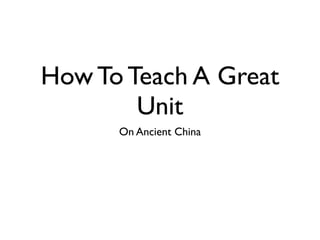
Ancient China: A Concise Guide to Its History and Culture
- 1. How To Teach A Great Unit On Ancient China
- 2. Why Study An Ancient Culture? • a) Because our own country is geographically close to that ancient culture •b) Because the ancient culture influenced modern line •c) Because the ancient culture influence our own country in particular •d) Because the ancient culture is interesting •e) Because we can learn things from the ancient culture •f) Because the country of the ancient culture is now powerful
- 3. Engaging • What couldn’t you do today without: • Paper • Rockets • Matches
- 4. Predicting What We Might Find Out • Think about the last ancient culture we studied? What might we find out about this one?
- 5. Beginning With A Map
- 6. Beginning With A Map China Physical Terrain Australia Physical Terrain
- 7. Developing Vocabulary Archaeology civilisation written records BCE excavation CE buried army evidence historian
- 8. Popplet
- 9. Jog The Web
- 10. Simploos
- 11. Shi Huangdi • Non fiction: Something (an idea, event or person) / happened / but (there was a problem) or moreover (extra details) / so (what was the outcome)
- 12. Shi Huangdi Before its unification under Qin Shihuangdi, its First Emperor (259 – 210 BC), China was made up of seven major states which were often at war with each other, vying for power and supremacy. Historians call this time the Warring States period (475 – 221 BC). The First Emperor’s ancestors were from a small state in the far west of the region called Qin (pronounced chin). The Qin were horse breeders for the ruling Zhou people (pronounced joe). After the Zhou gave them land for the task, they began to organise themselves and develop political skills. They gradually assumed power, giving their leaders the title of ‘Duke of Qin’ and then in 325 BC raising it to ‘King of Qin’.When they conquered and occupied the lands that belonged to the Zhou, the Kings of Qin also felt they had inherited the right to rule from them. That feeling fuelled the ambition of the 13 year old boy Ying Zheng, who became King of Qin in 246 BC. In 221 BC the King of Qin defeated the last of the Warring States and gave his state’s name to the unified empire. Historians believe that this is the origin of the western word China.He chose a new title for himself: Qin Shihuangdi, which means First August and Divine Emperor of Qin:‘First’ because he planned a long line of successors ‘August and Divine’ as he was now equal to a god ‘Emperor’ to separate himself from his ancestors who were only kings and dukes, and align himself with mythical emperors of the past.
- 13. Work It Out
- 14. Fakewall
- 15. Explain Back Qin Shi Huang conquered all opposing states and unified China in 221 BCE, establishing the Qin Dynasty. Intending to impose centralized rule and prevent the resurgence of feudal lords, he ordered the destruction of the wall sections that divided his empire along the former state borders. To protect the empire against intrusions by the Xiongnu people from the north, he ordered the building of a new wall to connect the remaining fortifications along the empire's new northern frontier. Transporting the large quantity of materials required for construction was difficult, so builders always tried to use local resources. Stones from the mountains were used over mountain ranges, while rammed earth was used for construction in the plains. There are no surviving historical records indicating the exact length and course of the Qin Dynasty walls. Most of the ancient walls have eroded away over the centuries, and very few sections remain today. The human cost of the construction is unknown, but it has been estimated by some authors that hundreds of thousands,[13] if not up to a million, workers died building the Qin wall. [14][15] Later, the Han, Sui, and Northern dynasties all repaired, rebuilt, or expanded sections of the Great Wall at great cost to defend themselves against northern invaders.[16]
- 16. Explain Back 1.Explain a concept back without using certain key words that were used to explain the concept in the first place (i.e explain what a symbol means, an issue is - and then ask students to explain it back in different words) 2.Explain a concept back using different examples (i.e this is an example of the issue, or character - explain it back to me using one of these different examples) 3.Explain a concept back using a non-example. A non-example is an example that could be mistaken for an example - but is actually not an example. Give students a list of examples (of symbols, techniques, issues etc...) and non-examples - and ask them to explain why one is an example and another isn’t. 4.Ask students to read content and then explain the main points by creating a flow chart or map 5.Ask students to explain back concepts in picture format, as an annotated picture or as a comic. 6.Ask students to verbally explain back content. For homework they need to explain content or a process to someone else. 7.Ask students to create a vodcast of themselves explaining content or demonstrating a procedure. Students can use the web tool Screen-Cast-O-Matic to record themselves and anything on their computer screen: http://www.screencast-o-matic.com/.
- 17. Pie Chart •Personal ability •Personal interests •Family’s social position •Gender
- 18. Glogster
- 19. Prezi
- 20. Popplet
- 21. Thank you...
Editor's Notes
- \n
- \n
- \n
- \n
- \n
- \n
- \n
- \n
- \n
- \n
- \n
- \n
- \n
- \n
- \n
- \n
- \n
- \n
- \n
- \n
- \n
